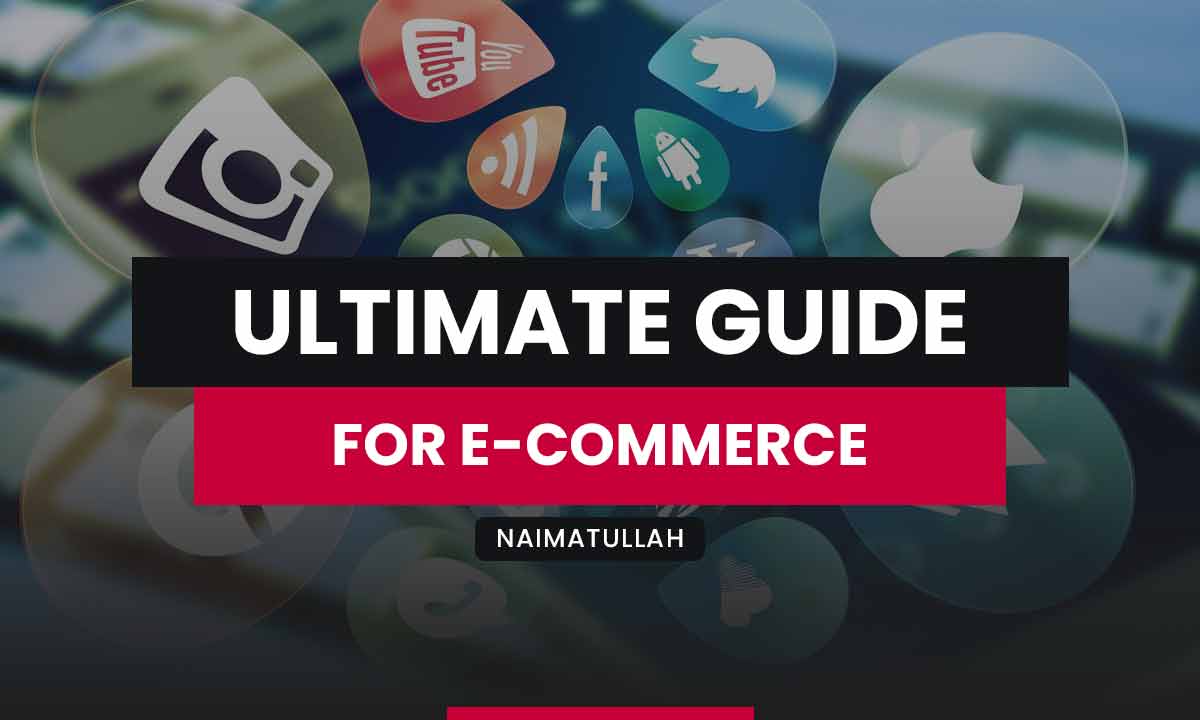
BLOG DETAIL
The Ultimate Guide to SEO for E-commerce Websites
- Naimatullah
- April 3, 2023
- 5:27 pm

Introduction:
If you run an e-commerce website, you know how important it is to drive traffic and sales. One of the most effective ways to do this is through search engine optimization (SEO). SEO can help your website rank higher in search engine results pages (SERPs), which can lead to more traffic, more sales, and more revenue. In this guide, we’ll walk you through the key elements of SEO for e-commerce websites and provide tips on how to optimize your site for better rankings.
Keyword Research:
The first step in any SEO campaign is keyword research. This involves identifying the keywords and phrases that people are using to search for products and services like yours. There are many keyword research tools available, including Google Keyword Planner, SEMrush, and Ahrefs. Use these tools to identify high-volume, low-competition keywords that are relevant to your products and services. Once you have a list of keywords, use them to optimize your website content.On-Page Optimization
On-page optimization refers to the elements on your website that you can control. This includes your website content, meta tags, headings, and images. Use your target keywords in your website content, but don’t overdo it. Keyword stuffing can lead to penalties from search engines. Make sure your website content is well-written, informative, and engaging.Use descriptive and keyword-rich meta tags, including title tags and meta descriptions. These are the snippets of text that appear in search engine results pages. They should accurately describe your page content and include your target keywords.
Use headings to organize your content and make it easier for users to read. Use H1 tags for your main headings and H2 tags for subheadings. Use alt tags for your images, and make sure they are descriptive and include your target keywords.
Technical SEO
Technical SEO refers to the elements of your website that affect how search engines crawl and index your site. This includes your website structure, URL structure, sitemap, and robots.txt file. Make sure your website structure is logical and easy to navigate. Use a clear and concise URL structure, and avoid using long and complicated URLs.Create a sitemap to help search engines crawl and index your site. This is a file that lists all the pages on your site and their relationships to one another. Use a robots.txt file to tell search engines which pages on your site to crawl and which to exclude.
Link Building
Link building is the process of acquiring backlinks to your website from other sites. Backlinks are important because they signal to search engines that your website is authoritative and trustworthy. There are many ways to acquire backlinks, including guest blogging, broken link building, and influencer outreach.Guest blogging involves writing articles for other websites and including a link back to your site in the author bio or within the article. Broken link building involves finding broken links on other websites and suggesting your content as a replacement. Influencer outreach involves reaching out to influencers in your industry and asking them to link to your content.
Local SEO
if you have a physical store, it’s important to optimize your website for local search. This includes claiming your Google My Business listing, optimizing your website content for local keywords, and building local citations.Claiming your Google My Business listing is essential for local SEO. This listing appears in Google Maps and search results and provides users with important information about your business, including your address, phone number, and hours of operation.
Optimizing your website content for local keywords involves using keywords that include your city or region. For example, if you run a coffee shop in San Francisco, use keywords like “San Francisco coffee shop” or “coffee shop in San Francisco.”
What Is SEO for E-Commerce?
1. Perform Keyword Research the Right Way
Keyword research is an essential component of e-commerce SEO. To perform keyword research effectively, follow these steps:
Use Keyword Research Tools – Use keyword research tools such as Google Keyword Planner, SEMrush, and Ahrefs to identify high-volume, low-competition keywords that are relevant to your products and services. These tools can help you generate ideas for new keywords, analyze search volumes and competition levels, and identify keyword trends over time.
Focus on Relevant Keywords – Focus on keywords that are relevant to your products and services. Avoid targeting keywords that are too broad or generic, as these are often more competitive and harder to rank for. Instead, target specific keywords that reflect the intent of your target audience.
Analyze Your Competitors – Analyze your competitors’ websites to see which keywords they are targeting. Look for gaps in their keyword strategy and target those keywords to gain a competitive advantage.
Using Uber suggest and Answer The Public for SEO E-Commerce Research
In addition to Google Keyword Planner, SEMrush, and Ahrefs, you can also use other keyword research tools such as Uber suggest and Answer The Public for e-commerce SEO research. Uber suggest can help you identify new keyword opportunities, analyze search volumes, and track your website’s rankings. Answer The Public can help you generate content ideas and identify long-tail keywords that your target audience is searching for.
2. Optimize Product Pages to Improve Ranking
Product pages are the most critical pages on your e-commerce website. Here are some tips for optimizing your product pages:
Use Unique and Descriptive Titles – Use unique and descriptive titles that include your target keywords. Avoid using generic titles that are not relevant to your product.
Include High-Quality Images – Include high-quality images that showcase your products from multiple angles. Use descriptive file names and alt tags that include your target keywords.
Provide Detailed Product Descriptions – Provide detailed product descriptions that include your target keywords. Use bullet points and subheadings to make the content more scannable and readable.
Add Customer Reviews and Ratings – Adding customer reviews and ratings can improve your search engine rankings and increase consumer trust.
3. Make Sure Your Site Is User Friendly
User experience is a crucial component of e-commerce SEO. Here are some tips for improving your website’s user experience:
Make Your Site Mobile-Friendly – With more and more people accessing the internet on their mobile devices, it’s essential to make sure your website is mobile-friendly.
Use Clear and Concise Language – Use clear and concise language that is easy to understand. Avoid using industry jargon or technical language that might confuse your users.
Use High-Quality Images and Videos – Use high-quality images and videos that load quickly and showcase your products in the best possible light.
Make Your Website Easy to Navigate – Make it easy for users to navigate your website and find what they are looking for. Use clear and descriptive navigation menus, and make sure your search function is easy to use.
4. Don’t Forget Long-Tail Keywords
Long-tail keywords are longer, more specific phrases that are less competitive than shorter, more general keywords. Here are some tips for using long-tail keywords:
Identify Long-Tail Keywords – Use keyword research tools to identify long-tail keywords that are relevant to your products and services.
Use Long-Tail Keywords in Your Product Descriptions – Use long-tail keywords in your product descriptions and category pages to attract more qualified traffic to your site.
Create Content Around Long-Tail Keywords – Create blog content around long-tail keywords to attract more traffic to your site.
5. Use a Simple URL Structure
A simple URL structure can improve your website’s usability and make it easier for search engines to crawl and index your site. Here are some tips for using a simple URL structure:
Use Clear and Concise URLs – Use clear and concise URLs that include your target keywords.
Avoid Long and Complicated URLs – Avoid using long and complicated URLs that can confuse search engines and users.
Use Hyphens to Separate Words – Use hyphens to separate words in your URLs to make them more readable.
6.Use Schema Markups to Help Google and Users Understand Content
Schema markups are a type of structured data that helps search engines and users understand your website’s content. Here are some tips for using schema markups:
Use Schema Markups for Product Pages – Use schema markups to provide more detailed information about your products, such as pricing, availability, and reviews.
Use Schema Markups for Reviews and Ratings – Use schema markups to provide more detailed information about customer reviews and ratings.
Use Schema Markups for Local Business Information – If you have a physical store, use schema markups to provide more detailed information about your location and business hours.
7. Avoid Duplicate Pages and Content
Having duplicate pages and content on your e-commerce website can hurt your search engine rankings. Search engines like Google penalize websites with duplicate content because it can cause confusion for users and make it difficult for search engines to determine which version of the page is the most relevant. Here are some tips to avoid duplicate content:
Use Canonical Tags – Canonical tags are HTML tags that help search engines understand which version of a page is the primary version. By using canonical tags, you can consolidate duplicate content into one primary version, which can improve your search engine rankings.
Use 301 Redirects – If you have multiple versions of the same page, use 301 redirects to direct users and search engines to the primary version of the page.
8. Don’t Let Page Speed Kill Your Ranking
Page speed is an important ranking factor for search engines like Google. Slow-loading pages can frustrate users and cause them to abandon your website, which can hurt your search engine rankings. Here are some tips to improve your page speed:
Optimize Images – Large images can slow down your page loading times. Use image compression tools to reduce the file size of your images without sacrificing quality.
Use a Content Delivery Network (CDN) – A CDN can help distribute your website’s content across multiple servers, which can improve your page loading times.
Minimize HTTP Requests – HTTP requests are requests made by a web browser to load a page’s elements, such as images and scripts. The more HTTP requests a page has, the slower it will load. Minimize the number of HTTP requests by removing unnecessary elements from your pages.
9. Content Matters for E-Commerce
Content is an important part of any e-commerce SEO strategy. Not only does quality content help your website rank better in search engine results, but it can also improve user engagement and conversions. Here are some tips for creating quality content for your e-commerce website:
Create Unique Product Descriptions – Unique product descriptions can help your website stand out from the competition and improve your search engine rankings. Make sure to include relevant keywords in your product descriptions, but avoid keyword stuffing.
Create Blog Content – Blogging can help attract new customers to your website and improve your search engine rankings. Create blog content that is relevant to your industry and target audience.
10. Link Building for E-Commerce
Link building is an important part of any SEO strategy, including e-commerce SEO. Building high-quality backlinks can improve your website’s domain authority, which can improve your search engine rankings. Here are some tips for building high-quality backlinks for your e-commerce website:
Reach Out to Influencers – Reach out to influencers in your industry and ask if they would be willing to feature your products on their website or social media channels.
Guest Blogging – Guest blogging on other websites can help you build high-quality backlinks to your e-commerce website. Make sure to include a link back to your website in your guest blog post.
Broken Link Building – Broken link building involves finding broken links on other websites and reaching out to the website owner to suggest replacing the broken link with a link to your website. This strategy can help you build high-quality backlinks and improve your search engine rankings.



The Importance of Color in Graphic Design



Web Accessibility What It Is and How to Design for It

How to be an Entrepreneur in 30 clear ways


